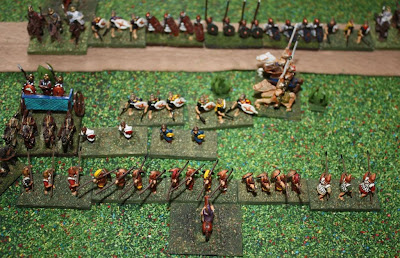This is game 14 in playtesting my ancient rules - Ancient Battlelines Clash. Previous games used my rules called Ancient Warrior Battles. The latest version is on its own blog page. I am playtesting the rules by replaying all the Peter Sides scenarios from his Historical Battles books. ABC is designed to finish in under an hour on 2'x2' tables.
Battle of Crimisus
Carthage lands in Sicily with a large army and Timoleon leads a Greek army to stop them plundering Sicily.
Here is a link of interest and that I used to create the scenario:
Wikipedia article
Plutarch Life of Timoleon 25-29
Diodorus Book 16.77-80
I also used Lost Battles (Sabin).
Changes to the Peter Side's scenario
The Peter Sides scenario had both forces lines up against one another on a slope with bad going occurring after 1d6 turns. Looking at Plutarch, Diodorus and the Lost Battles interpretation, it seemed that initially some Carthaginian forces were engaged (10,000 including chariots) and then later more Carthaginians crossed the river and those were then fought. So I had to go back to the original (translated) sources to come up with a scenario more like the Lost Battle one. I can see where I think Peter Sides was going with the way he set up the scenario - the initial battle could be seen as inconclusive and not really a melee, allowing one to then set up the battle as a more conventional one.
I did reduced the units by about 1/3 to account for wider width that was in the original scenario.
Troops
Greeks
 |
| Greeks - cavalty on the flanks, skirmishers at the foor of the hill and hoplites and peltasts on the hill. |
2 Heavy Cavalry, HC
2 Peltast, LI, fortitude+1
2 Skirmisher, SI, javelin
1 General +1 (Timoleon)
Breakpoint:6
Carthaginians
 |
| Carthaginians - chariots, pelatasts and skirmishers represent the 10,000 already across the river. Heavy infantry, cavalry and more peltasts about the cross the river to the rear. |
2 Hoplites HI, protection +1, phalanx
5 Light Infantry, LI
4 Skirmisher, SI, javelin
2 Heavy Chariot, HCH
2 Cavalry, HC
1 -1 General (Asdrubal)
Breakpoint: 9
Deployment
Deployment:
 |
| Overhead shot with Greeks at the top and Carthaginians and river at the bottom. |
I had to add rules for crossable rivers - had rules for streams, none for crossable rivers. Crossable rivers count as difficult terrain (reduces combat value) but take an entire move - stop when contact, one move to get to other side. Count as in difficult when in contact or in the river.
After 1+d3 turns, all terrain becomes rough (to account for the turn in the weather). As the movement rate is faster in my rules than DBA, I reduced the random turn range from that in the original scenario (1d6).
The Game
Greeks advance and the flank cavalry charges the chariots. The Greek right flank manages to rout the opposing chariot (lucky 6 roll and then successful pursuit) and the left flank sees both cavalry and chariot in disorder.
 |
| Victorious Timoleon and heavy cavalry (on the Greek right flank) |
 |
| While on the left, the heavy cavalry (with attached subordinate commander) still in melee with the opposing heavy cavalry. |
 |
| View of the line from the Greek side. Note the Greek heavy cavalry in the centre that is rolling up the Carthaginian peltasts while the rest of the Carthaginian army is still crossing the river. |
The cavalry routs another peltast, a Greek hoplite advances due to skirmisher fire and forces a Carthaginian peltast to rout; pursues into the river and routs an opposing hoplite.
A roll of a 6 sees the left flank chariot routed. This then has the Carthaginians reaching their breakpoint. They were unlucky to lose the hoplite, I think they would have done a bit of damage once out of the river.
 |
| A view of the forces at game end. The Carthaginians are in the river (except for the Greek hoplite from the last picture). |
Well, that game was faster than I thought. And I played this is daylight and I am better at photos of the game when playing at night. If I was going to re-do the battle, I think I would only put 1 peltast (not 3) on the side of the river with the chariots and have peltasts more with the river crossing. As it is the breakpoint can be reached by routing the forces that have already crossed the river and only one more heavy unit the river crossing.
This is the last of the hoplite-type battles, the next is the first battle of the Latin War. Then there is a whole bunch of pikes (Alexander and Successors) and early Roman battles coming. But...to speed up playtesting, I have ordered a used copy of Imperator, a light campaign system by the same author (Bill Banks) as Ancients. As Ancient Battlelines clash owes some of its lineage to Ancients, I think I can use Imperator to generate a a bunch of battles around a particular epoch. I may be wrong though - will find out when it arrives.




















































































.jpg)



